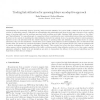Free Online Productivity Tools
i2Speak
i2Symbol
i2OCR
iTex2Img
iWeb2Print
iWeb2Shot
i2Type
iPdf2Split
iPdf2Merge
i2Bopomofo
i2Arabic
i2Style
i2Image
i2PDF
iLatex2Rtf
Sci2ools
COMCOM
2010
2010
Trading link utilization for queueing delays: An adaptive approach
Understanding the relationship between queueing delays and link utilization for general traffic conditions is an important open problem in networking research. Difficulties in understanding this relationship stem from the fact that it depends on the complex nature of arriving traffic and the problems associated with modelling such traffic. Existing AQM schemes achieve a “low delay” and “high utilization” by responding early to congestion without considering the exact relationship between delay and utilization. However, in the context of exploiting the delay/utilization tradeoff, the optimal choice of a queueing scheme’s control parameter depends on the cost associated with the relative importance of queueing delay and utilization. The optimal choice of control parameter is the one that maximizes a benefit that can be defined as the difference between utilization and cost associated with queuing delay. We present two practical algorithms, Optimal Drop-Tail (ODT) and Optim...
| Added | 24 Jan 2011 |
| Updated | 24 Jan 2011 |
| Type | Journal |
| Year | 2010 |
| Where | COMCOM |
| Authors | Rade Stanojevic, Robert Shorten |
Comments (0)

